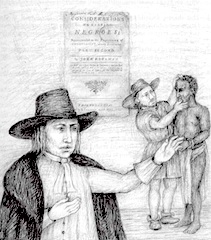|
J. William T. "Bill" Youngs, American Realities, Volume One:
Historical Episodes from First Settlements to the Civil War, Chapter Four |
"The Treaty of Penn with the Indians," by Benjamin West,
courtesy of the Wikipedia Commons |
4. Reform in Colonial America
|
|
|
During the early eighteenth century, the British colonies in North America were among the most prosperous places on earth. The literacy rate was exceptionally high. Widespread land ownership meant that the average family was well fed and well housed. And yet there were many exceptions to this pattern of abundance. Slaves, of course, were hardly prosperous, nor were Indians and poor whites. Some colonists noted with regret the debased condition of their less-fortunate neighbors, and they lamented also the spiritual cost of rampant materialism. John Woolman, a Quaker reformer, was one such critic. His argument with colonial society in its formative years helped lay the foundation for an enduring American reform tradition.
|
Author Reads From the Text
With their Indian guides the two Quakers pressed deeper into the wilderness, crossing the steep, rocky Blue Ridge Mountains, following a narrow trail, crowded in by bushes and hindered by fallen timber. Often they were “wet with traveling in the rain.” On a typical night they “kindled a fire, with our tent open to it, then laid some bushes next the ground, and put our blankets upon them for our bed.” Sometimes they swam their horses across deep streams; often they were paddled in canoes along rivers while Indians rode their horses along the rough trails to rendezvous points. They encountered rattlesnakes, struggled across patches of fallen trees, waded through swamps, and at least once lost precious hours trying to recover a strayed horse. Woolman wanted to be among the Indians “that I might feel and understand their life and the spirit they live in.” And now, day by day, he felt himself drawn further into Indian country, both geographically and spiritually.
At one point along the trail the travelers camped beside trees whose bark had been peeled back to provide a surface for paintings. There they saw “various representations of men going to and returning from the wars, and of some being killed in battle.” Looking at these forest images Woolman was moved by the struggles of these people: This was a path heretofore used by warriors, and as I walked about viewing those Indian histories, which were painted mostly in red or black, and thinking on the innumerable afflictions which the proud, fierce spirit produceth in the world, also on the toils and fatigues of warriors in traveling over mountains and deserts; on their miseries and distresses when far from home and wounded by their enemies; of the bruises and great weariness in chasing one another over the rocks and mountains; of the restless, unquiet state of mind of those who live in this spirit, and of the hatred which mutually grows up in the minds of their children,—the desire to cherish the spirit of love and peace among these people arose very fresh in me.
At one point along the trail the travelers camped beside trees whose bark had been peeled back to provide a surface for paintings. There they saw “various representations of men going to and returning from the wars, and of some being killed in battle.” Looking at these forest images Woolman was moved by the struggles of these people: This was a path heretofore used by warriors, and as I walked about viewing those Indian histories, which were painted mostly in red or black, and thinking on the innumerable afflictions which the proud, fierce spirit produceth in the world, also on the toils and fatigues of warriors in traveling over mountains and deserts; on their miseries and distresses when far from home and wounded by their enemies; of the bruises and great weariness in chasing one another over the rocks and mountains; of the restless, unquiet state of mind of those who live in this spirit, and of the hatred which mutually grows up in the minds of their children,—the desire to cherish the spirit of love and peace among these people arose very fresh in me.

